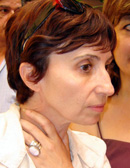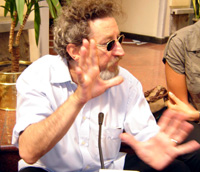Rober Gedikyan was born in Marcel, France and that is where he mainly makes his films. Gedikyan always portrays the real image of the suburbs of Marcel in his films. “It’s very important for me to describe the level of society, which I myself belong to,” says the film director. His heroes (most often heroines played by his wife, actress Arian Askarid) are average people living, loving, betraying and trying to find the answers to their questions. Gedikyan has been working with the same team for many years now.
R. Gedikyan’s wife, a very interesting and talented actress Arian Askarid and actor Zherar Meilyan (of Armenian origin) almost always play in his films. Gedikyan thinks that this is important in that the characters are continual and the audience trusts these actors more.
“I don’t want the audience to see the difference when the actors are playing on stage and when they are simply living on the scene,” says the film director.
 His heroes find the solutions to their problems in their inner world. The most important thing for Gedikyan, as a director, is man’s individuality. The films “Money isn’t happiness”, “Marius and Janet”, “Mary John and her two loves”, “The Walker in the Mars field” (about the last days of French president François Mitterrand), “My father is an Engineer”, “Everything is calm in the city” are proof of that.
His heroes find the solutions to their problems in their inner world. The most important thing for Gedikyan, as a director, is man’s individuality. The films “Money isn’t happiness”, “Marius and Janet”, “Mary John and her two loves”, “The Walker in the Mars field” (about the last days of French president François Mitterrand), “My father is an Engineer”, “Everything is calm in the city” are proof of that.
“There is only one struggle in life and that’s the struggle between the rich and the poor,” says Gedikyan.
Most of the heroes don’t wish to change; they don’t even want to get rich because they realize that they will lose more. R. Gedikyan will soon direct another film about three friends, who remember their past and try to find the answers to questions that are everlasting. The setting will be in Marcel. R. Gedikyan’s last film was also about the tie between the past and the present.
The title of the film “Journey to Armenia” already tells us that the film is about tracing the roots and Armenia. The main character of the film, Anna (played by Arian Askarid), doesn’t want to leave France and is forced to make the trip to Armenia. She doesn’t know anything about her father’s Homeland and doesn’t even want to know, but she finds peace in her soul after a couple of days of living in an Armenia full of contrasts. There are many love stories in the film, which come from the past and make their way to the present with a happy ending. For Anna, that love story is visible since she has a husband in France. As Arian Askarid told me in Yerevan, “My heroine finds love, but she understands that she is incapable of loving.” Anna’s father, knowing that he is on the verge of dying, prefers to return to the Homeland and be with the Armenian woman from whom he had separated a long time ago. Another heroine, played by young Armenian actress Shoghik Grigoryan, falls in love and gets married at the end of the movie.
“I don’t make films by placing emphasis on special effects and innovations, but rather I place emphasis on the actors’ professionalism and how the plot enfolds,” says R. Gedikyan. The scenes take place in Armenia and the events can be analyzed thoroughly. The images of the rich neighborhoods are substituted by the daily routines of the extremely poor. The film shows the criminal masterminds of Yerevan and the places to go sightseeing in Armenia, the tolerance of the corrupted authorities, the bad life of the working class and the desire to leave the Homeland in search of a better life abroad. You don’t see any calls for patriotism or phony slogans in the film. The Homeland begins from the small things and you don’t talk about that out loud, you can only whisper to the person who has befriended you based on circumstances. It’s clear that the film, which was produced last year, isn’t really coherent to today’s Armenia. But the people are the same-they live their lives, work, dream about love and the good life, cordially talk about their historical Homeland and are always ready to mention Mount Ararat as the symbol of Armenia to foreigners. The film “Journey to Armenia” won a prize during the “Golden Apricot” film festival. The interview with the film director was sponsored by “Viva Cell”.
– Do you expect to see “Journey to Armenia” reach success in different countries around the world and interest non-Armenians?
– I don’t make films for only one ethnic group. I want my films to be interesting for everyone. Even French film directors make films based on stories that will interest any kind of audience. While directing the film “Journey to Armenia”, I wanted to talk about the problem of being Armenian and not tell about Armenians. Although the film is about a journey and you can see that in the title, however this is not just a journey; it has a deeper meaning to it. Each person who makes the trip to Armenia sees Armenia through his eyes. I didn’t make the film in Armenia because I’m Armenian, rather because I consider Armenia as the crossroads between the East and the West. The heroine of the film gets an image of Armenia by meeting different people throughout the film. Not one opinion can be considered a general opinion. I want everyone to grasp the concept of the film. I was born in an average family-my father was almost illiterate and spent all his life working in the slums of Marcel. I also want people like him to understand my films.
– Do people really retrace their roots today in Europe?
– Yes, many people are talking about identification. The individual and his individuality is the most talked-about issue in a time when globalization is taking its toll.
– Your film portrays the politics and economy of Armenia and the lifestyle. Can the film help Armenians give the correct analysis about Armenia’s past?
– I’m in the film industry and I don’t want to politicize the reality. But I did want to analyze Armenia’s politics in some way through the means of this film. I didn’t want to show Armenia as simply a land of tears, tragedies and the Genocide, rather show people that it’s a country where there is love. People love each other, smile to one another and are happy being on their land. Armenia is a lively country that needs to look ahead and move forward.
– Don’t you think that the Armenia you portray differs from today’s Armenia?
– Some things have changed, but not really.
– As you watch the film, it becomes clear that you like one hero-General Yervand, who is ready to get Armenia back on its feet without any self-interest. Do you think that enthusiasm is the only way one can do many things?
– Of course, I really have a liking for such people and it seems as though I have created the one, continual character for all my films-the one ready to be on the poor people’s side, help them and give them hope for progress. I consider that as the goal of my life and I try to reach that goal through my films and my articles published in French newspapers and magazines. In my opinion, all intellectuals must have a goal to help the needy.
– What difficulties did you encounter while filming?
– I didn’t really have any difficulties. We got the permission and were able to film in Yerevan, the military units and Khor Virap.
-There are many comic scenes in the film. Does that help present serious issues more easily?
– That’s the correct way and everyone ties comedy with presenting serious issues. Comic scenes help the audience like the film more.
– It seems as though nostalgia and longing are always the topics for Armenian film directors.
– Of course, each Armenian learns something new from his new Homeland by living in America or Europe, he changes his lifestyle, daily routine and culture. However, he always has a longing for Armenia, even if he has never visited Armenia. Although I do think that Armenians living in America are more similar to Americans than Armenians. I can bring up France as an example and say that Armenians in France want to stay Armenian.
– Were you able to get acquainted with Armenian film production during the “Golden Apricot” film festival?
– I haven’t seen one Armenian film because I didn’t have enough time, but I hope that I will get to see many of the films later.

